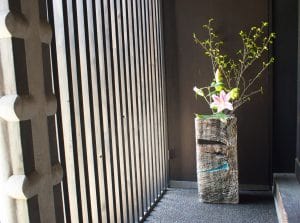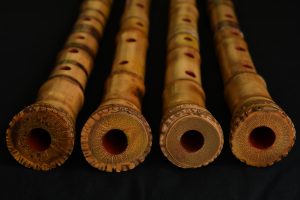The Library's Biblio Lotus, opens a new window team is delighted to present this interview series, hoping to elevate AAPI (Asian Americans and Pacific Islanders) communities' voices and celebrate their culture. The interviewees are in different fields and from various backgrounds, but their dedication to AAPI histories and cultures helps form our diverse and dynamic community in Pima County.
Patricia Deridder is the founder and executive director of Yume Japanese Gardens, opens a new window, a Tucson non-profit that aims to share the tranquility of a Japanese garden with our community. We're grateful to her for sitting down with us and sharing some insights into how the gardens came to be and some of the unique qualities of a Japanese garden.
How did Yume Japanese Gardens of Tucson begin?
I had lived in Japan for fifteen years and I thought what better way to try to express the Japanese culture, aesthetics, and feeling towards nature than a Japanese garden.
Did it start as a kind of museum and then develop more as a garden?
No, I started it as a garden right away. With a garden you can share the culture, you can share the festivals, and and you can share the special days they have.
There's a lot of things you can do. With a museum, you're a little more limited. At the end, I made a small museum within the gardens. And many people think the gardens are a museum in their own right. When I first came to the United States, one of my friends in Japan was rebuilding their house. And in the countryside, they basically take the old house to the field and burn them down because everything is wood and paper. You have a little bit of glass, of course, but for the most part that's what they do. I asked them if I could take a few pieces from their house. I integrated—I didn't know I was going to be making a Japanese garden at that time, it was so long ago—but when I did finally do the gardens, I had some tiles that I put on top of the gates, the sliding doors, and the little house that we have. So I did integrate a log of it, as much as I could twenty years later.
What makes a Japanese garden unique compared to a European- or English-style garden?
The difference is that you are trying to bring landscapes and nature into a smaller space. So you don't really copy, but you take the essence of it. So most of the trees, unless they are shading trees, are human sized. Everything is built in a humanistic way. We use a lot of stones, and those are very important. They are almost as important as the greenery. The gardens we try to represent here are not palace gardens. They are what people would have had about two, three hundred years ago in Kyoto. They are courtyard gardens. And they created those courtyards because the landscape made it so that Kyoto was built in a valley and it was very hot in the summer. In order to respond to that, they would build a house and have several courtyards within, or they could have just one—like a big atrium if you want.
So it's designed like an open house?
Right. They had sliding doors that could be made of reeds instead of solid, so there could be a breeze going all the time. And so what I wanted to show here in Tucson was those courtyard gardens more so than just regular noble gardens or big park gardens or other types of things that you can see in Japan.
Is there any specific care for Japanese plants in the Southern Arizona climate?
We have a hard time having maples here, but Nandina, Heavenly Bamboo, for example, grows very well here. It thrives. Boxwood or Myrtle bushes, they do as well over there as they do here. Bamboo, in general, does very well here. Actually, at the entrance of our gardens here we have Timber Bamboo that's as tall as a three-story high building.
You teach ikebana classes at the gardens. Can you tell us more about that?
Ikebana is Japanese flower arrangement. It started 550 years ago in Japan, in Kyoto as a matter of fact. Its oldest school was named "ikenobo.' A lot of people confuse ikebana, ikenobo. Ikebana evolved and there are now about 2,000 schools.
Do you collaborate with other Japanese gardens in the Southwest?
In Phoenix, yes we do collaborate a lot. We had something that we call the Thousand Crane Healing for Tucson at the beginning of COVID, and we gathered about three thousand cranes and made a big exhibit out of it. We made mobiles out of them. We put them through the trees, had a big exhibit. So that we did in Tucson, and then we brought them about two month ago to Phoenix and set them up over there for their own festival.
How did you build other connections with the Japanese community in Pima County?
Pima County used to have a very nice... kind of a Japanese concours, and they had a big festival at the same time. They would invite many different groups and individuals to perform—Taiko drummer, shakukachi and flute players, people who do kyudo and judo. Children and young adults would give speeches in Japanese. That's how I got to know quite a few people.
Do you have any upcoming programs you'd like to tell us about?
We recently had a talented person named Paul Amiel come out and play the shakuhachi flute, and the harp. We decorated the gardens with umbrellas, and candles and people took an evening stroll. That was the conclusion of our season. People don't come in the summer so we're closed for our regular summer closure until October 1, 2021. We will close until October. Maybe we'll try to get some grants and reopen with lots of events.
Can you tell us about how Japanese gardens serve as healing places?
The National Japanese Association had a three-day program that was about healing in Japanese gardens. Several thousand people went through the program. The purpose of it was to help people who have, for example, lost a person. Or they have a problem they don't know how to deal with themselves. They need to find a new way to look at things. And it's a six-week program, minimum six weeks. And you walk through the gardens and you journal about a specific subject that we provide in a book.
Can you share your favorite book with us?
Let's keep it in the Japanese realm. I'd say Shōgun, opens a new window by James Clavell. It was very true to the life of the times. And it was a fun story to read. Very long, but very educational at the same time, too.
What are you currently reading?
Currently, it's more like "what to do with your plants." How to trim in the more Japanese way. I did this garden, but I didn't have the training for it. I'm not a gardener to begin with. So I did it, and then I met a Japanese third-generation landscape architect from Kyoto. And I said I want to do those as true to the principles as it can be. I asked, "What am I doing wrong? How can I improve?" And so we worked on it together. He never said I was wrong. Japanese don't do that to you. But if I didn’t do it right, he would have really told me and he would have never come back. Now he comes back every year to check if things are ok. And he brings sometimes brings a couple of people that help pruning the big trees.
Post by Megan H., Kirk-Bear Canyon Library
Read the entire interview transcript here, opens a new window | Listen to the full interview here, opens a new window
Do you want to learn more about Japanese gardening? The Library has some books you may want to check out!







